
VISUAL CONSTRAINTS IN WRITTEN WORD RECOGNITION:
E
VIDENCE FROM THE OPTIMAL VIEWING POSITION EFFECT
Marc Brysbaert
1
Tatjana Nazir
2
1
Royal Holloway, University of London
2
CNRS, Université Lyon 1
address : Marc Brysbaert
Royal Holloway, University of London
Department of Psychology
Egham TW20 OEX
United Kingdom
marc.brysbaert@rhul.ac.uk
A
BSTRACT
In this paper we review the literature on visual constraints in written word processing.
We notice that not all letters are equally visible to the reader. The letter that is most
visible is the letter that is fixated. The visibility of the other letters depends on the
distance between the letters and the fixation location, whether the letters are outer or
inner letters of the word, and whether the letters lie to the left or to the right of the
fixation location. Because of these three factors, word recognition depends on the
viewing position. In languages read from left to right, the optimal viewing position is
situated between the beginning and the middle of the word. This optimal viewing
position is the result of an interplay of four variables: the distance between the
viewing position and the farthest letter, the fact that the word beginning is usually
more informative than the word end, the fact that during reading words have been
recognised a lot of times after fixation on this letter position, and the fact that stimuli
in the right visual field have direct access to the left cerebral hemisphere. For
languages read from right to left, the first three variables pull the optimal viewing
position towards the right side of the word (which is the word beginning), but the
fourth variable counteracts these forces to some extent. Therefore, the asymmetry of
the OVP curve is less clear in Hebrew and Arabic than in French and Dutch.
VISUAL CONSTRAINTS IN WRITTEN WORD RECOGNITION:
E
VIDENCE FROM THE OPTIMAL VIEWING POSITION EFFECT
It is now abundantly clear that reading and visual word recognition are not simply
based on orthographic information but involve the activation of phonological codes.
This has been shown both at the level of individual word processing (e.g., Drieghe &
Brysbaert, 2002; Harm & Seidenberg, 2004) and at the level of sentence and
discourse understanding (e.g., Brysbaert, Grondelaers, & Ratinckx, 2000; Inhoff,
Connine, Eiter, Radach, & Heller, 2004). Also, children with deficient phonological
awareness (i.e., awareness that spoken words consist of sequences of sounds,
phonemes) are at risk for not acquiring good reading skills (e.g., Schatschneider,
Fletcher, Francis, Carlson, & Foorman, 2004).
Unfortunately, the recent emphasis on phonological coding in reading has
overshadowed the fact that a written or printed word is a visual stimulus in the first
place and that limitations of the human visual system put strong constraints on the
speed and the accuracy with which words can be recognised. To redress the balance,
we will review these constraints in the present paper.
1. THE DROP OF VISUAL ACUITY OUTSIDE THE FIXATION LOCATION
The most important variable that limits visual word recognition is the steep drop of
visual acuity outside the centre of fixation. Even at an eccentricity of 1 degree, there
is already a reduction in visual acuity to about 60% of maximum (Wertheim, 1894).
This makes that humans find it difficult to recognise words presented a few letter
positions to the left or to the right of the fixation location (unless these words are large
enough). In such situations, participants have a strong tendency to move their eyes so
that the stimulus word becomes fixated.
Starting from the observation that in reading participants mainly fixate words between
the beginning and the middle of the word, O’Regan (1981) wondered whether the
drop of acuity outside the fixation location not only had implications for the
processing of parafoveally presented words (i.e., words presented a few letter
positions away from the fixation location) but also for the processing of foveally
presented words. His reasoning was that if the drop of visual acuity is important
enough, it should be easier to recognise words after fixation on the middle letter than
after fixation on the first or the last letter. Central fixation makes maximally use of the
high acuity region around the fixation location, whereas fixation on the first letter
makes the last letters fall more than 1 degree away from the fixation location (under
usual reading conditions there are some 3 to 4 letters per degree of visual angle). The
same is true for fixations on the last letter: They make the first letters fall in
parafoveal vision.
To test the idea, O’Regan, Lévy-Schoen, Pynte, and Brugaillère (1984) systematically
manipulated the participants’ initial fixation location within a word by displaying
words in such a way that they were shifted horizontally relative to an imposed fixation

location. More specifically, participants had to fixate a gap between two vertically
aligned fixation lines placed just above and below the horizontal position where the
words were presented. Then, a word appeared shifted so that a different letter position
fell between the two fixation lines (see Figure 1).
Figure 1: Example of how the initial fixation position is manipulated in the
optimal viewing position paradigm. The participant is asked to fixate the gap
between two vertically aligned lines. Words are presented in such a way that the
participants initially look at different letter positions within the words.
An impressive series of experiments has established a consistent pattern of results due
to the fixation position manipulation. This pattern is present in word naming, lexical
decision, and perceptual identification. In addition, it has been observed in many
different languages (French, Dutch, Hebrew, Arabic, Hebrew, Japanese). Figure 2
shows this pattern, which has been called the Optimal Viewing Position (OVP) effect,
for words of 5 and 7 letters in three different tasks: Word naming, lexical decision,
and perceptual identification. In all tasks, word identification was best when the
words were fixated between the beginning and the middle, and performance dropped
when participants were forced to fixate on the extreme letters of the words. The
processing cost was larger for fixations on the end letters than for fixations on the
beginning letters.
Figure 2 : OVP effect for 5-letter (squares) and 7-letter (triangles) words. Left
panel: word naming; middle panel: lexical decision (data from Brysbaert, 1992,
1994). Notice that for these two panels, not all letter positions within the 7-letter
words were tested. Right panel: perceptual identification (data from Stevens &
Grainger, 2003).
|
watch
|
|
watch
|
|
watch
|

Perceptual identification
0.30
0.40
0.50
0.60
0.70
0.80
0.90
-3 -2 -1 0 1 2 3
letter initially fixated relative to word
centre
identification probability
To directly test the idea that the drop of visual acuity is equally important for foveally
presented and parafoveally presented words, Brysbaert et al. (1996) investigated
perceptual identification for 5-letter words presented so that the observers looked
either four character spaces in front of the word, two character spaces in front of the
word, on the first letter of the word, on the middle letter of the word, on the last letter
of the word, two character spaces after the word, or four character spaces after the
word. Presentation duration of the words varied from 14 ms to 70 ms. Figure 3 shows
the results. As can be seen, there was no discontinuity between the performance to
foveally and parafoveally presented words. Performance levels at all fixation
positions were well captured by a Gaussian curve that was shifted slightly to the left
(accounting for the fact that performance was better when words were presented in
the right visual field than in the left visual field; see below).
Figure 3 : The continuity of the drop of performance for foveally presented and
parafoveally presented 5-letter words (data from Brysbaert et al., 1996). Five
different presentation durations were used. The data for each duration fell on a
Gaussian distribution that was slightly shifted to the left of the word centre.
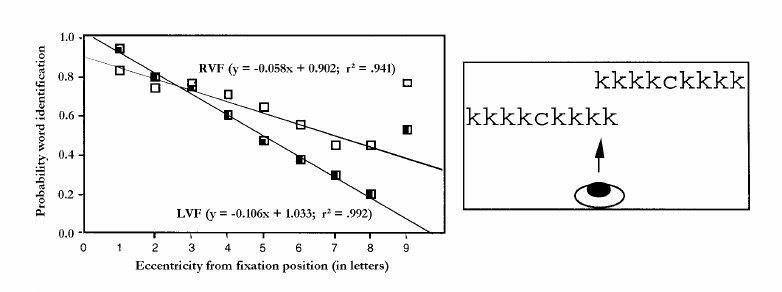
2. MEASURING THE DROP OF PERCEPTIBILITY FOR EMBEDDED LETTERS
To get a more precise measure of the drop of letter perceptibility as a function of
stimulus eccentricity, Nazir, O’Regan, and Jacobs (1991) inserted lower-case target
letters in tachistoscopically presented strings of 8 k’s (e.g. kkkkckkkk) and asked
participants to identify the target letter. The strings were presented in such a way that
participants either fixated on the first or the last k. Target letters could be presented at
each location of the k-string. Figure 4 shows the findings of the study, as a function of
fixation position (beginning vs. end) and position of the target letter.
Figure 4 : Recognition probability of letters presented within a sequence of ks,
either fixated on the first letter (open symbols) or on the last letter (closed
symbols; Nazir et al., 1991).
Nazir et al. (1991) observed three important effects. First, identification of the most
extreme letter (i.e., the last letter when fixated at the beginning or the first letter when
fixated at the end) was better than identification of the nearby inner letters. This is due
to the well-known phenomenon of lateral inhibition (Bouma, 1970): Letters are more
difficult to recognise when they are embedded within other letters than when they are
presented against an empty background. Second, when the most extreme letter was
discarded the drop of performance could be approximated rather well with a linear
regression (notice that a large part of the slopes of the normal distributions in Figure 3
can also be approximated by a linear regression line). Finally, Nazir et al. observed
that the drop of perceptibility was stronger in the left visual field (when participants
fixated on the last k) than in the right visual field (when participants fixated on the
first k). The slope of the linear regression line was 1.8 times steeper in the left visual
field than in the right visual field.
3. SIMULATING OVP CURVES ON THE BASIS OF LETTER PECEPTIBILITY
MEASURES
Subsequently, Nazir et al. (1991) examined whether they could predict the OVP
curves obtained in perceptual identification, on the basis of the perceptibility of the
individual letters and by assuming that a word is recognised only when all its
constituent letters are recognised. Table 1 illustrates the reasoning. The first row

shows the probability of identifying each letter when the participant fixates on the
first letter. The probability of identifying the first letter when the eyes are on this letter
is 1.00. The probability of identifying the second letter is .94 (a drop of .06). The
probability of identifying the third letter is .88 (another drop of .06), and so on.
Likewise, when the eyes are looking at the last letter (the last line of Table 1), the
probability of identifying this letter is 1.00. The probability of identifying the second
last letter is .89. This is a drop of .11, due to the fact that the perceptibility of letters
decreases 1.8 times more rapidly as a function of eccentricity in the left visual field
than in the right visual field. Chances of identifying the third last letter when the eyes
are looking at the last letter, are .78 (i.e., another drop of .11) and so on.
Position of
fixated letter
Probability of letter identification
Probability of
recognizing a
chain of 5
letters
1 2 3 4 5
1 1 .94 .88 .82 .76 .52
2 .89 1 .94 .88 .82 .60
3 .78 .89 1 .94 .88 .57
4 .68 .78 .89 1 .94 .44
5 .57 .68 .78 .89 1 .27
Table 1 : Probability of identifying a word under the assumptions (1) that all
letters must be identified, (2) that the chances of perceiving a letter drop linearly
as a function of the distance from the fixation location, and (3) that the drop of
perceptibility is 1.8 times higher in the left visual field than in the right visual
field.
Figure 5 shows the results of the simulation and compares them with empirical data
obtained for 5-letter words. As can be seen, the simulation captures the asymmetry in
the OVP curve very well, but underestimates the overall recognition probability of the
words. Further simulations indicated that the model predicts a strong word length
effect (poorer performance for long words than for short words), which is not
observed in the empirical data of adults either (although it is present in the data of
beginning readers; Aghababian, & Nazir, 2000).
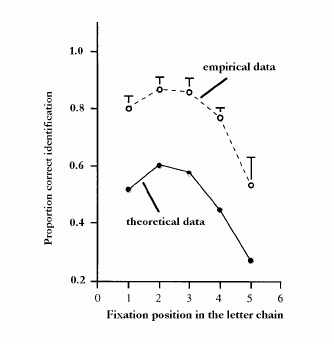
Figure 5 : Theoretical and empirical OVP curves (theoretical data based on the
model presented in Table 1; empirical data from Nazir et al. (1991).
There are two reasons why the Nazir et al.’s (1991) simulation underestimated the
overall word recognition probability. The first is that it did not take into account the
higher perceptibility of the first and the last letter (see the rightmost data points in
Figure 4). The second is that the model assumed that all letters must be recognised
before a word can be identified. The latter assumption is not realistic, given that many
words can be guessed on the basis of a subset of the letters that make the word (e.g.,
tabl-, h-us-).
Stevens and Grainger (2003) examined whether it was possible to predict the
empirical OVP curves on the basis of individual letter recognition probabilities by
taking into account the probabilities of recognising words on the basis of incomplete
information. They were able to do so, if they used a coding scheme in which not the
absolute letter positions were used (1
st
, 2
nd
, 3
rd
, …) but relative letter positions (first,
last, or middle letter). The latter observation agrees with the fact that words can be
recognised rather easily when the positions of middle letters have been swapped
(Grainger & Whitney, 2004; Perea & Lupker, 2004). Ben Boutayab (2004) recently
also showed that it is possible to simulate empirical OVP curves on the basis of
individual letter recognition probabilities and the probability of producing the target
word on the basis of partial input.
4. ACCOUNTING FOR THE ASYMMETRY IN THE OVP EFFECT
In the previous sections, we have seen that because of the drop of visual acuity
outside the fixation location and because of the existence of lateral inhibition not all
letters of a word are equally visible. This makes that a word is more rapidly
recognised when readers fixate on the centre letters than when readers fixate on the
outer letters. Two factors are involved in the word processing quality (either accuracy
or speed): (1) the perceptibility of the individual letters as a function of the fixation
location, and (2) the extent to which the most visible letters isolate the target word
from its competitors.
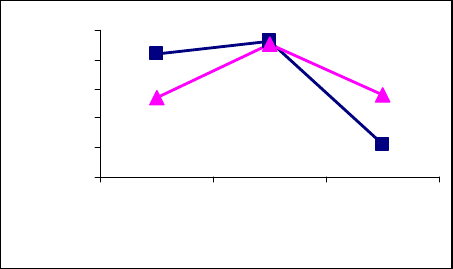
One element that still has to be accounted for, however, is the asymmetry in the OVP
curve. Why are words recognised better after fixation on the first letters than after
fixation on the last letters? Three factors seem to be involved
The first factor is the observation that in general the initial letters of a word are more
informative about the identity of the word than the last letters. Some authors have
argued that this is due to the way spoken words are recognised (for a review, see
Shillcock, Ellison, & Monaghan, 2000). Because the production of a spoken word
takes a few hundred milliseconds (depending on the length), it is more efficient and
communicatively effective to pack the maximum possible information at the
beginning of the word. Then, spoken words can be recognised before the speaker has
ended the pronunciation, leaving more time for other (syntax and discourse-related)
processes.
The effect of the information distribution within words has been examined in a
number of papers (Brysbaert et al., 1996; Farid & Grainger, 1996; O’Regan et al.,
1984; Pynte, Kennedy, & Murray, 1991) and the results have been consistent. The
information distribution has some influence, but on its own it does not reverse the
asymmetry of the OVP effect. Figure 6 shows the results of Brysbaert et al. (1996).
Five-letter words were used that had a high informative beginning (the words had a
chance of 84% to be correctly produced by participants given the first 3 letters,
against a chance of only 9% when given the last 3 letters) or that had a high
informative end (71% correct target production on the basis of the last 3 letters vs. 8%
correct target production on the basis of the first 3 letters). The task was perceptual
identification after tachistoscopic presentation.
0.40
0.50
0.60
0.70
0.80
0.90
135
letter fixated in 5-letter word
percentage correct
Figure 6: Identification probability for five-letter words as a function of initial
fixation (first, middle, last letter) and information distribution within the word
(informative beginning [squares] vs. informative end).
As can be seen in Figure 6, the OVP pattern indeed changed as a function of the most
informative word part, but whereas for words with a high informative beginning
performance was much better after initial fixation on the first letter than after initial
fixation on the last letter, no comparable word end advantage was observed for words
with a high informative end. For these words, performance was equal after fixation on
the first letter and fixation on the last letter.
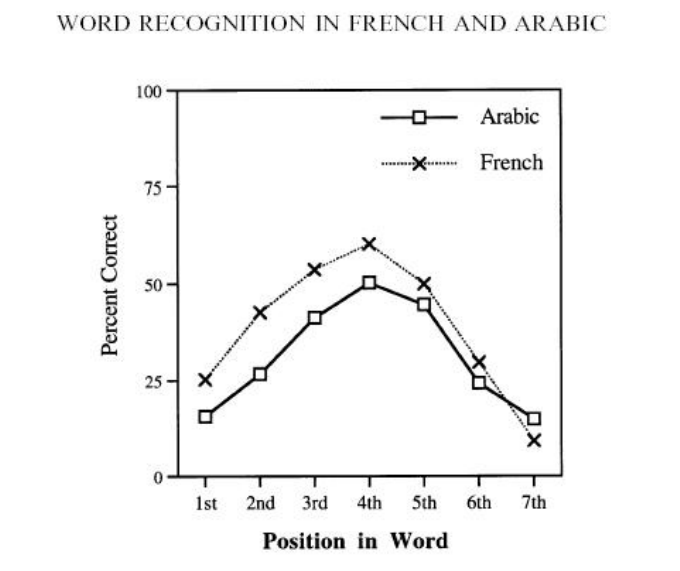
A second factor that plays a role in the left-right asymmetry of the OVP effect is the
reading direction. The OVP curve is much more symmetric for languages read from
right to left (Arabic and Hebrew) than for languages read from left to right (French
and Dutch). Figure 7 shows perceptual identification data for tachistoscopically
presented Arabic and French words (Farid & Grainger, 1996). As can be seen, the
OVP curve for Arabic has become symmetric; it has not turned into an advantage for
fixations on the rightmost (initial) letter of the word. A similar pattern has been
observed in Hebrew (Nazir, Ben-Boutayab, Decoppet, Deutsch, & Frost, 2004).
Figure 7: The OVP effect for Arabic and French seven-letter words; perceptual
identification (figure from Farid & Grainger, 1996).
The main reason why the reading direction influences the OVP effect probably has to
do with low-level perceptual learning. Nazir (2000; Nazir et al., 2004) argued that left
to right text reading results in many words being recognised in the right visual field
(either when they are in parafoveal vision or after fixation on the initial letters). There
is evidence that repeated presentation of a visual stimulus in the same region of the
visual field leads to enhanced discrimination of that stimulus at that particular region
(Nazir & O’Regan, 1990) but not at other nearby parts of the visual field. Given this
location-dependent perceptual learning, words will be more easily recognised after
fixation on the first letters than after fixation on the last letters, because during
reading the eyes land more often on the first part of a word than on the last part of a
word (see Figure 8).
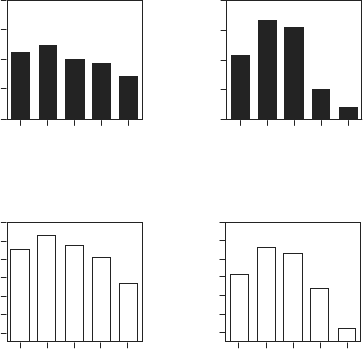
0
10
20
30
40
12345
5-letter words
STATISTICS
Frequency in %
Landing site in the word
9-letter words
0
10
20
30
40
13 795
Proportion correct
PERFORMANC
E
.4
.5
.6
.7
.8
.9
1
9-letter words
13579
.4
.5
.6
.7
.8
.9
1
5-letter words
12345
Fixation Zones
Figure 8. Correlation between the distribution of the landing sites of the eyes
during reading and word recognition performance. Top panel. Distribution of
landing positions in 5- and 9- letter Roman words, observed during reading.
Bottom panel. Probability of correct responses for 5- to 9- letter words as a
function of the location of the eyes on the word (from Nazir, 2000).
Notice that the perceptual learning factor, just like the information distribution factor,
predicts that the OVP effect in a language read from right to left (Arabic, Hebrew)
should be the mirror image of the effect observed in languages read from left to right
(French, Dutch). So, one final factor must be invoked to explain why the OVP effect
is more asymmetric for languages that are read from left to right than for languages
read from right to left.
Brysbaert (1994, 2004) argued that this factor is the asymmetry of the brain for
language processing. For the vast majority of people, the left cerebral hemisphere is
more important for language processing than the right cerebral hemisphere. Because
information in the right visual half field is projected directly onto the left cerebral
hemisphere whereas information in the left visual half field requires interhemispheric
transfer to reach the left cerebral hemisphere, word recognition will be slightly easier
after fixation on the leftmost letter of a word than after fixation on the rightmost letter.
This will be true both for languages read from left to right and for languages read
from right to left (remember that the leftmost letter is the first letter of a word when
the word is read from left to right, but the last letter of the word when the word is read
from right to left).
Brysbaert (1994) tested the laterality hypothesis by comparing the OVP effect in
participants with left hemisphere language dominance and participants with atypical
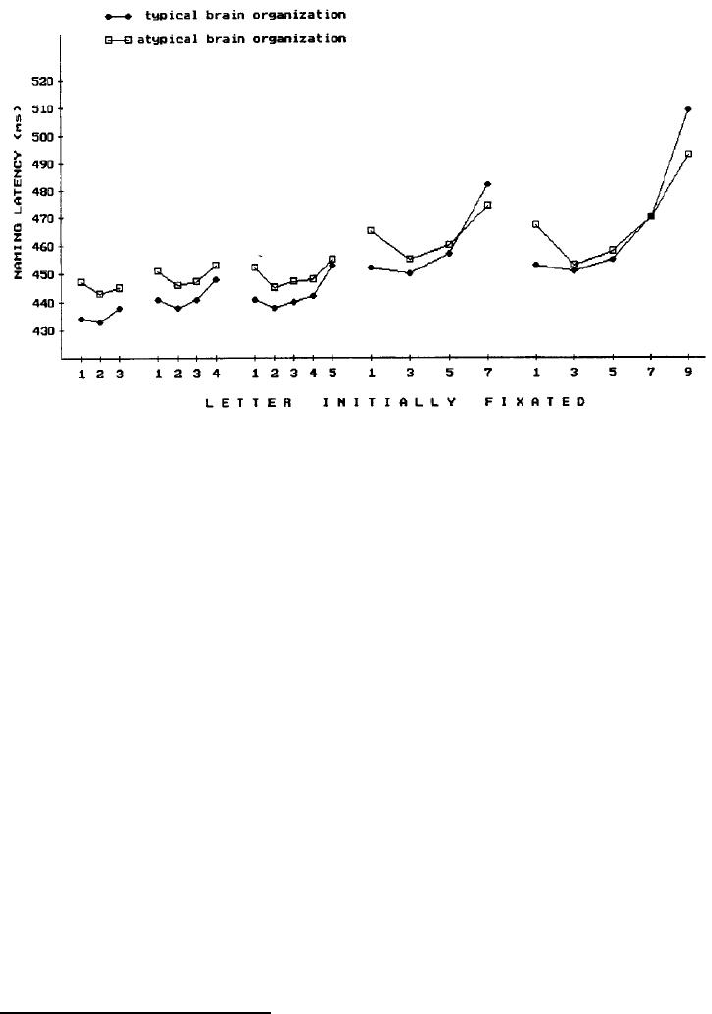
language dominance
1
. Participants named words of three, four, five, seven, and nine
letters. Figure 9 shows the results.
Figure 9: Naming latencies for words of 3, 4, 5, 7, and 9 letters as a function of
the initial fixation location and the cerebral dominance of the participants
(figure from Brysbaert, 1994).
As can be seen in Figure 9, the word beginning advantage observed in unselected
participants (the vast majority of whom are left dominant for language) did not turn
into a word end advantage for participants with right hemisphere dominance, but the
effect of cerebral dominance on the asymmetry of the OVP curve was significant. So,
a third reason for the strong word beginning advantage in words that are read from
left to right is related to the fact that fixation on the leftmost letter makes the whole
word fall in the right visual half field which has direct connections to the dominant
left hemisphere. This finding also implies that the fovea does not project information
bilaterally to both hemispheres, as is sometimes assumed (see Brysbaert, 2004;
Lavidor & Walsh, 2004; Leff, 2004; Monaghan, Shillcock, & McDonald, 2004;
Whitney, 2004 for further discussion of this issue).
To further test the laterality hypothesis, Nazir et al. (2004) examined the letter
perceptibility as a function of eccentricity for Hebrew letters. Remember from Figure
4, that for French participants the drop of letter visibility as a function of letter
eccentricity is 1.8 times steeper in the left visual field than in the right visual field. If
perceptual learning is the only factor that contributes to this left-right asymmetry, then
for Hebrew readers and Hebrew letters, the pattern should be reversed with an 1.8
times steeper drop in letter perceptibility for letters presented in the right visual field
than for letters presented in the left visual field. On the other hand, if the right visual
1
Assessment procedures available at the time did not allow the author to be 100% sure that participants
were right hemisphere language dominant; some participants could have had a symmetric language
representation. Therefore, the data of figure 9 are likely to slightly underestimate the effect due to
cerebral dominance. We intend to repeat the study in the near future using brain imaging to assess the
cerebral dominance (Knecht et al., 2000).
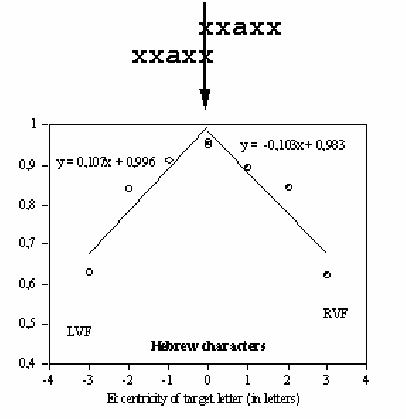
field advantage for French participants is the sum of perceptual learning and cerebral
asymmetry, then the asymmetry should be much smaller for Hebrew participants,
because for them perceptual learning (which favours the left visual field) and cerebral
dominance (which favours the right visual field) should cancel each other out. This is
exactly the pattern Nazir et al. (2004) obtained (see Figure 10). There was no
difference between the regression lines in the left and the right visual field.
Figure 10: Recognition probability of Hebrew letters in a homogenous string of
characters, as a function of letter eccentricity and fixation location (left character
of the string or right character).
5. CONCLUSION
In this paper, we have reviewed the literature on visual constraints in written word
processing. We have seen that not all letters are equally visible to the reader. The
letter that is most visible is the letter that is fixated. The visibility of the other letters
depends on (1) the distance between the letters and the fixation location, (2) whether
the letters are outer or inner letters of the word, and (3) whether the letters lie to the
left or to the right of the fixation location. Because of these three factors, word
recognition depends on the viewing position. In languages read from left to right, the
optimal viewing position is situated between the beginning and the middle of the
word. This optimal viewing position is the result of an interplay of four variables: (1)
the distance between the viewing position and the farthest letter, (2) the fact that the
word beginning is usually more informative than the word end, (3) the fact that during
reading, words have been recognised a lot of times after fixation on this letter
position, and (4) the fact that stimuli in the right visual field have direct access to the
left cerebral hemisphere. For languages read from right to left, the first three variables
pull the optimal viewing position towards the right side of the word (which is the
word beginning), but the fourth variable counteracts these forces to some extent.
Therefore, the asymmetry of the OVP curve is less clear in Hebrew and Arabic than in
French and Dutch.
Our review has concentrated entirely on the recognition of individual words. This
raises the question to what extent the OVP phenomenon has implications for text
reading, given that in this situation several words are presented on a line of text. We
venture that the implications of the OVP phenomenon will be particularly strong for
beginning readers, because for quite some time they read text materials word by word.
The situation is slightly more complicated for proficient readers, because they pick up
information from the parafoveal word n+1 while they are still fixating on word n.
This can be concluded from the fact that the reading rate slows down when letter
information from the parafoveal word is denied (e.g., because the word remains
masked until the eyes land on it) and also from the fact that skilled adult readers skip
about one third of the English words (predominantly the short ones; Brysbaert,
Drieghe, & Vitu, in press). This means that in text reading proficient readers quite
often have rudimentary information about the word, in particular the word beginning,
when they land on a word. This advance knowledge is likely to attenuate the OVP
effect in text reading relative to isolated word recognition, as has indeed been
observed by Vitu, O’Regan, & Mittau (1990). However, it seems unlikely that the
advance knowledge could nullify the visual constraints discussed in this paper.
Indeed, the research group of McDonald and Shillcock recently showed that several
of these constraints are needed for a good understanding of eye movement control
both in normal (McDonald & Shillcock, 2005) and in dyslexic readers (Kelly, Jones,
McDonald, & Shillcock, 2004).
References
Aghababian, V., & Nazir, T.A. (2000). Developing normal reading skills: Aspects of
the visual processes underlying word recognition. Journal of Experimental Child
Psychology, 76, 123-150.
Ben Boutayab, N. (2004). Interactions des facteurs visuels et lexicaux au cours de la
reconnaissance des mots écrits. University of Lyon : Unpublished PhD thesis.
Bouma, H., (1970). Interaction effects in parafoveal letter recognition. Nature, 226,
177-178.
Brysbaert, M. (1992). Interhemispheric transfer in reading. University of Leuven:
Unpublished PhD Thesis.
Brysbaert, M. (1994). Interhemispheric transfer and the processing of foveally
presented stimuli. Behavioural Brain Research, 64, 151-161.
Brysbaert, M. (2004). The importance of interhemispheric transfer for foveal vision:
A factor that has been overlooked in theories of visual word recognition and
object perception. Brain and Language, 88, 259-267.
Brysbaert, M., Drieghe, D., & Vitu, F. (in press). Word skipping: Implications for
theories of eye movement control in reading. In G. Underwood (Ed.), Cognitive
Processes in Eye Guidance. Oxford: Oxford University Press.
Brysbaert, M., Grondelaers, S., & Ratinckx, E. (2000). Sentence reading: Do we make
use of orthographic cues in homophones? Acta Psychologica, 105, 31-56.
Brysbaert, M., Vitu, F., & Schroyens, W. (1996). The right visual field advantage and
the optimal viewing position effect: On the relation between foveal and parafoveal
word recognition. Neuropsychology, 10, 385-395.
Drieghe, D., & Brysbaert, M. (2002). Strategic effects in associative priming with
words, homophones, and pseudohomophones. Journal of Experimental
Psychology: Learning, Memory, and Cognition, 28, 951-961.
Farid, M., & Grainger, J. (1996). How initial fixation position influences visual word
recognition: A comparison of French and Arabic. Brain and Language, 53, 351-
368.
Grainger, J., & Whitney, C. (2004). Does the huamn mnid raed wrods as a wlohe?
Trends in Cognitive Science, 8, 58-59.
Harm, M.W., & Seidenberg, M.S. (2004). Computing the meaning of words in
reading: Cooperative division of labor between visual and phonological
processes. Psychological Review, 111, 662-720.
Inhoff, A.W., Connine, C., Eiter, B., Radach, R., & Heller, D. (2004). Phonological
representation of words in working memory during sentence reading.
Psychonomic Bulletin & Review, 11, 320-325.
Kelly, M.L., Jones, M.W., McDonald, S.A., & Shillcock, R.C. (2004). Dyslexics’ eye
fixations may accommodate to hemispheric desynchronization. Neuroreport, 15,
2629-2632.
Knecht, S., Drager, B., Deppe, M., Bobe, L., Lohmann, H., Floel, A., Ringelstein,
E.G., & Henningsen, H. (2000). Handedness and hemispheric language
dominance in healthy humans. Brain, 123, 2512-2518.
Lavidor, M., & Walsh, V. (2004). Magnetic stimulation studies of foveal vision.
Brain and Language, 88, 331-338.
Leff, A. (2004). A historical review of the representation of the visual field in primary
visual cortex with special reference to the neural mechanisms underlying macular
sparing. Brain and Language, 88, 268-278.
McDonald, S.A., & Shillcock, R.C. (2005). The implications of foveal splitting for
saccade planning in reading. Vision Research, 45, 801-820.
Monaghan, P., Shillcock, R., & McDonald, S. (2004). Hemispheric asymmetries in
the split-fovea model of semantic processing. Brain and Language, 88, 339-354.
Nazir, T.A. (2000). Traces of print along the visual pathway. In A. Kennedy, R.
Radach, D. Heller, & J. Pynte (Eds.), Reading as a perceptual process (pp. 3-22).
Oxford: Elsevier.
Nazir, T.A., Ben-Boutayab, N., Decoppet, N., Deutsch, A., & Frost, R. (2004).
Reading habits, perceptual learning, and recognition of printed words. Brain and
Language, 88, 294-311.
Nazir, T.A., & O’Regan, J.K. (1990). Some results on the translation invariance in the
human visual system. Spatial Vision, 3, 81-100.
Nazir, T.A., O’Regan, J.K., & Jacobs, A.M. (1991). On words and their letters.
Bulletin of the Psychonomic Society, 29, 171-174.
O’Regan, J.K. (1981). The convenient viewing position hypothesis. In D.F. Fisher,
R.A. Monty, & J.W. Senders (Eds.), Eye movements, cognition, and visual
perception (pp. 289-298). Hillsdale, NJ: Erlbaum.
O’Regan, J.K., Lévy-Schoen, A., Pynte, J., & Brugaillère, B. (1984). Convenient
fixation location within isolated words of different length and structure. Journal
of Experimental Psychology: Human Perception and Performance, 10, 250-257.
Perea, M., & Lupker, S.J. (2004). Can CANISO activate CASINO? Transposed letter
similarity effects with nonadjacent letter positions. Journal of Memory and
Language, 51, 231-246.
Pynte, J., Kennedy, A., & Murray, W. (1991). Within-word inspection strategies in
continuous reading: Time course of perceptual, lexical and contextual processes.
Journal of Experimental Psychology: Human Perception and Performance, 17,
458-470.
Schatschneider, D., Fletcher, J.M., Francis, D.J., Carlson, C.D., & Foorman, B.R.
(2004). Kindergarten prediction of reading skills: A longitudinal comparative
analysis. Journal of Educational Psychology, 96, 265-282.
Shillcock, R., Ellison, T.M., Monaghan, P. (2000). Eye-fixation behavior, lexical
storage, and visual word recognition in a split processing model. Psychological
Review, 107, 824-851.
Stevens, M., & Grainger, J. (2003). Letter visibility and the viewing position effect in
visual word recognition. Perception & Psychophysics, 65, 133-151.
Vitu, F., O’Regan, J.K., & Mittau, M. (1990). Optimal landing position in reading
isolated words and continuous text. Perception & Psychophysics, 47, 583-600.
Wertheim, T. (1894). Uber die indirekte Sehschärfe. Zeitschrift für Psychologie, 7,
172.
Whitney, C. (2004). Hemiphere-specific effects in word recognition do not require
hemisphere-specific modes of access. Brain and Language, 88, 279-293.
